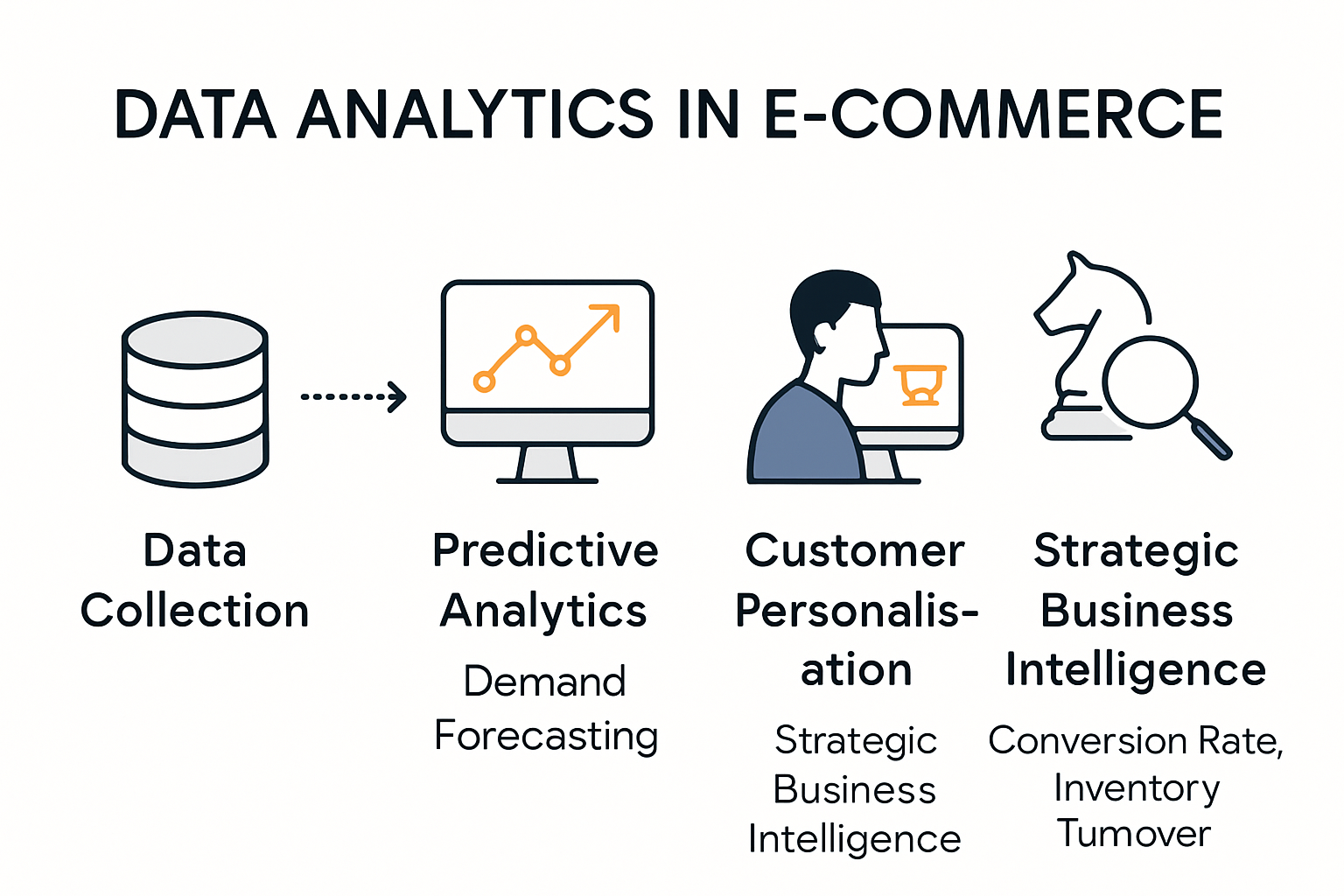Technology has completely rewritten the rules of shopping, shaping everything from how people browse to what makes them click "buy. You might expect that fancy algorithms or glossy websites are making all the difference. Surprisingly, the real revolution is subtler. Deep learning-based recommendation engines can now increase conversion rates by up to 12%, yet trust and ethical design are even more crucial for winning customer loyalty. What truly changes the game is how businesses blend these powerful tools with a genuine respect for consumer privacy and personalization.
Table of Contents
- How Technology Changes Online Shopping Behaviour.
- Tools That Improve Customer Experience And Conversion
- The Role Of Data And Analytics In E-Commerce Success
- Future Technology Trends In Digital Shopping
Quick Summary
| Takeaway | Explanation |
|---|---|
| Leverage AI for Personalization | Use AI technologies to create tailored shopping experiences based on individual customer data and preferences. |
| Prioritize Ethical Design | Implement user-friendly interfaces that build trust, avoiding manipulative design practices that drive customers away. |
| Utilize Predictive Analytics | Employ data-driven forecasting to optimize inventory and meet consumer demand efficiently, enhancing customer satisfaction. |
| Integrate Immersive Technologies | Adopt augmented and virtual reality to offer engaging product interactions, improving customer confidence in purchasing decisions. |
| Emphasize Privacy in Transactions | Focus on decentralized commerce solutions that secure user data and enable greater control over personal information. |
How Technology Changes Online Shopping Behaviour.
Technology has fundamentally transformed how consumers interact with online shopping platforms, creating a complex ecosystem of digital experiences that reshape purchasing decisions. Modern consumers now navigate an intricate landscape where technological innovations continuously redefine their expectations and interactions with digital marketplaces.
The Rise of Artificial Intelligence in Consumer Interactions.
Artificial intelligence has become a pivotal force in revolutionizing online shopping behavior. According to a comprehensive study from Hungary, consumer acceptance of AI in online shopping critically depends on two primary factors: trust and perceived usefulness. Businesses are increasingly leveraging AI to create personalized shopping experiences that adapt in real time to individual user preferences.
Modern AI technologies enable sophisticated recommendation systems that analyze user browsing history, past purchases, and even social media interactions to generate highly targeted product suggestions. These intelligent systems go beyond simple algorithmic matching, using machine learning to understand nuanced consumer preferences and predict potential purchasing patterns with remarkable accuracy.
Ethical Design and Consumer Trust
Technology's impact on shopping behavior extends beyond mere functionality into the realm of user experience and ethical design. Research investigating dark patterns in online shopping reveals that manipulative interface designs can significantly erode consumer trust. Online retailers must now carefully balance technological innovation with transparent, user-friendly interfaces that respect consumer autonomy.
Consumers have become increasingly sophisticated in their digital interactions, quickly identifying and rejecting platforms that employ deceptive design practices. This shift demands that businesses prioritise not just technological capability, but also the ethical implementation of digital shopping tools. Our comprehensive guide on tracking future trends provides deeper insights into maintaining consumer trust through responsible technological integration.
The proliferation of advanced tracking technologies, consent management systems, and transparent data practices has empowered consumers to make more informed choices about their online shopping experiences. Businesses that successfully navigate this complex landscape can transform technological capabilities into genuine consumer value, creating more meaningful and trustworthy digital interactions.
Ultimately, technology continues to reshape online shopping behavior by providing increasingly personalized, intuitive, and responsive digital experiences. As artificial intelligence, machine learning, and ethical design converge, consumers can expect shopping platforms that not only meet their immediate needs but also anticipate and adapt to their evolving preferences with unprecedented precision.
Tools That Improve Customer Experience and Conversion
The digital marketplace has witnessed a remarkable transformation in tools designed to enhance customer experience and drive conversion rates. Modern businesses now leverage sophisticated technological solutions that go far beyond traditional marketing strategies, creating more personalized and engaging shopping experiences.
Advanced Recommendation Systems
Recommendation technologies have become incredibly sophisticated in recent years. Research on deep learning-based alternative product recommendations demonstrates that advanced algorithms can increase conversion rates by up to 12% through intelligent product embedding techniques. These systems analyze multiple data points including browsing history, purchase patterns, and user preferences to generate highly targeted suggestions.
Sophisticated machine learning models now enable businesses to predict customer needs with unprecedented accuracy. By utilizing complex neural networks and probabilistic models, recommendation engines can anticipate consumer desires before they are explicitly expressed. This predictive capability transforms the shopping experience from a transactional interaction to a more intuitive, personalized journey.
Immersive Visualization Technologies
Augmented reality and advanced visualization tools are revolutionizing how customers interact with products online. According to research on the ARShopping prototype, immersive technologies can significantly enhance customer decision-making by providing detailed product information through interactive visualizations. These tools allow consumers to experience products virtually, reducing uncertainty and increasing purchase confidence.
The integration of augmented reality enables customers to virtually try products, from clothing to furniture, creating a more engaging and interactive shopping experience. This technology bridges the gap between online and physical retail, addressing one of the primary challenges of e-commerce: the inability to physically examine products before purchase.

Dynamic Content Optimization
Dynamic content optimization represents another critical tool for improving customer experience and conversion rates. A study on multi-armed bandit algorithms revealed that intelligent content updating strategies can increase click-through rates by 6.13% and conversion rates by 16.1%. These advanced algorithms continuously learn and adapt content presentation based on real-time user interactions.
Explore our expert strategies for conversion optimization to understand how businesses can implement these cutting-edge technologies effectively. The key lies not just in deploying these tools, but in strategically integrating them to create seamless, intuitive user experiences.
Technology continues to push the boundaries of what's possible in customer engagement. By combining artificial intelligence, machine learning, and immersive visualization technologies, businesses can create shopping experiences that are not just transactional, but genuinely personalized and compelling. The future of e-commerce lies in understanding and anticipating customer needs through intelligent, adaptive technological solutions.
To help readers easily compare the advanced customer experience tools discussed, the following table summarizes their key features and measurable impacts in online retail environments.
| Tool | Key Features | Measurable Impact |
|---|---|---|
| Advanced Recommendation Systems | Personalized product suggestions using deep learning | Up to 12% increase in conversion rates |
| Immersive Visualization Technologies | Augmented/virtual reality for product interaction | Enhances purchase confidence |
| Dynamic Content Optimization | Real-time adaptation using multi-armed bandit algorithms | 6.13% more click-throughs, up to 16.1% more conversions |
The Role of Data and Analytics in E-Commerce Success
Data and analytics have become the cornerstone of strategic decision-making in modern e-commerce, transforming how businesses understand, engage, and serve their customers. The ability to collect, analyze, and interpret complex datasets has shifted from being a competitive advantage to an essential requirement for sustainable business growth.
Predictive Analytics and Demand Forecasting
Predictive analytics has emerged as a game-changing tool for e-commerce businesses seeking to optimize their operational strategies. According to SCORE's research, these advanced analytical techniques enable businesses to forecast product demand with remarkable accuracy, leading to significantly optimized inventory management. By anticipating market trends and consumer preferences, companies can reduce holding costs and minimize stockouts, directly enhancing customer satisfaction.
The sophisticated algorithms powering predictive analytics leverage historical sales data, seasonal trends, and emerging market signals to generate precise demand projections. This approach allows businesses to make data-driven decisions about product stocking, pricing strategies, and marketing resource allocation, effectively reducing financial risks associated with inventory management.
Personalization through Advanced Data Science
Data science has revolutionized the concept of personalization in e-commerce. The International Association of Business Analytics Certification emphasizes that analyzing data from multiple sources enables businesses to create hyper-personalized customer experiences. By understanding individual customer preferences, purchasing behaviors, and interaction patterns, companies can develop targeted marketing campaigns and product recommendations that resonate on a deeply individual level.
Modern data science techniques go beyond simple demographic segmentation. Machine learning algorithms can now predict customer preferences with unprecedented precision, enabling businesses to create dynamic, adaptive shopping experiences that feel intuitive and responsive to each user's unique needs.
Strategic Insights and Competitive Intelligence
E-commerce firms are increasingly recognizing data analytics as a critical tool for strategic planning. Research from the Journal of Interdisciplinary Research highlights how businesses are investing substantially in data analytics infrastructure to extract actionable insights from complex datasets. These insights provide a comprehensive understanding of market dynamics, consumer behavior trends, and emerging competitive landscapes.
Learn how to transform your analytics strategy to unlock deeper business intelligence. By integrating advanced analytical tools, businesses can move beyond reactive strategies to proactively shape their market positioning.

The future of e-commerce is inherently data-driven. As technological capabilities continue to evolve, businesses that can effectively harness the power of data analytics will be best positioned to create more intelligent, responsive, and customer-centric shopping experiences. The convergence of advanced algorithms, machine learning, and comprehensive data collection is not just changing how businesses operate-it's redefining the entire paradigm of digital commerce.
Future Technology Trends in Digital Shopping
The digital shopping landscape is rapidly evolving, driven by technological innovations that promise to fundamentally reshape how consumers interact with online marketplaces. As we look toward the future, emerging technologies are set to create more immersive, intelligent, and personalized shopping experiences that transcend current digital commerce capabilities.
Artificial Intelligence and Predictive Commerce
Artificial intelligence is poised to become the cornerstone of future digital shopping experiences. Advanced machine learning algorithms will enable unprecedented levels of predictive commerce, where shopping platforms anticipate consumer needs before they are explicitly expressed. These intelligent systems will combine multiple data points including browsing history, social media interactions, personal preferences, and contextual information to create hyper-personalized shopping journeys.
The next generation of AI-driven shopping experiences will move beyond simple recommendation engines. They will create dynamic, adaptive interfaces that modify themselves in real-time based on individual user interactions. This means each customer will effectively receive a unique, tailored shopping environment that feels intuitive and responsive to their specific requirements.
Immersive Technologies and Extended Reality
Extended reality technologies, including augmented and virtual reality, are set to transform digital shopping from a transactional experience to an immersive interaction. Consumers will be able to virtually try on clothing, test furniture placement in their homes, and examine product details with unprecedented precision. These technologies will bridge the gap between online and physical retail, addressing one of the primary limitations of current e-commerce platforms.
Advanced 3D modeling and real-time rendering technologies will enable photorealistic product representations that allow customers to examine items from multiple angles, understand material qualities, and make more informed purchasing decisions. The integration of haptic feedback technologies might even allow users to experience virtual product textures and weights, further enhancing the online shopping experience.
Decentralized and Privacy-Focused Commerce
The future of digital shopping will also be characterized by increased emphasis on user privacy and decentralized technologies. Blockchain and distributed ledger technologies will provide more transparent, secure transaction mechanisms that give consumers greater control over their personal data. Explore the evolving landscape of e-commerce tracking technologies to understand how these innovations are reshaping digital commerce.
Decentralized platforms will enable peer-to-peer transactions, reduce intermediary costs, and provide more direct connections between consumers and sellers. Smart contracts will automate complex transaction processes, ensuring transparency and reducing the potential for disputes. These technologies will not just be technical innovations but will represent a fundamental reimagining of how digital commerce operates.
As technological capabilities continue to expand, the boundaries between physical and digital shopping experiences will become increasingly blurred. Businesses that can successfully integrate emerging technologies while maintaining a human-centric approach will be best positioned to thrive in this new digital commerce ecosystem. The future of shopping is not just about selling products but about creating compelling, personalized experiences that anticipate and exceed customer expectations.
The following table provides a concise overview of the key future technology trends in digital shopping, highlighting their main characteristics and the benefits they bring to both businesses and consumers.
| Emerging Trend | Core Characteristics | Main Benefits |
|---|---|---|
| Artificial Intelligence & Predictive Commerce | Anticipates needs, dynamic personalization | Ultra-personalized experiences |
| Immersive Technologies & Extended Reality | Augmented/virtual reality, 3D and haptic product views | Informed purchase decisions |
| Decentralized & Privacy-Focused Commerce | Blockchain, peer-to-peer, user-controlled data | Increased privacy and transparency |
Frequently Asked Questions
How does artificial intelligence impact online shopping?
Artificial intelligence enhances online shopping by creating personalized experiences. It analyses consumer behavior, such as browsing history and past purchases, to provide tailored product recommendations, ultimately increasing engagement and conversion rates.
What role does ethical design play in online retail?
Ethical design is crucial in online retail as it fosters consumer trust. User-friendly interfaces that avoid manipulative practices can improve customer loyalty and satisfaction, encouraging repeat purchases and positive brand perception.
How can businesses utilize predictive analytics in e-commerce?
Businesses can use predictive analytics to accurately forecast demand and optimize inventory management. By analyzing historical sales data and market trends, companies can minimize stockouts and holding costs, ultimately enhancing customer satisfaction and operational efficiency.
What are immersive visualization technologies, and how do they benefit online shopping?
Immersive visualization technologies, such as augmented reality, allow consumers to virtually interact with products. This enhanced experience reduces uncertainty in purchasing decisions, leading to increased confidence and higher conversion rates.
Transform Your Customer Data Into Lasting Conversion Gains
Is your business struggling with incomplete data, unreliable tracking, or a lack of transparency in your online marketing efforts? As highlighted in our article, advanced technology alone is not enough. Building trust, maintaining consent, and gathering accurate data are now critical for true personalization and higher conversion rates.
Cutting-edge solutions like server-side tagging and robust consent management are key for marketers who demand both compliance and precision. With AdPage's powerful platform, you can completely overcome the uncertainty caused by browser-based tracking and data loss.

Imagine monitoring 100 percent of your conversions while respecting privacy and data compliance. Take back control by ensuring that every click and sale is counted. Start today by learning how server-side tagging and consent management can transform your marketing results. Visit AdPage now and see the difference for yourself.



.png)
